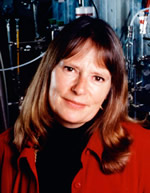 Barbara J. Finlayson-Pitts, University of California – Irvine Distinguished Professor, is internationally renowned for her research in atmospheric chemistry. She received her Bachelor degree from Trent University, followed one year later by a Masters and two years after that with a Doctorate from the University of California – Riverside. After post-docing at Riverside, she was on the faculty at California State University – Fullerton, moving to Irvine in 1994. She and James N. Pitts co-authored the widely-acclaimed text, Chemistry of the Upper and Lower Atmosphere: Theory, Experiments, and Applications. The book's title concisely summarizes the areas of her interest: chemistry in and on particulates in the atmosphere. Much of what is known about nitrogen oxide chemistry, catalysis on salt (ocean spray) particle surfaces, and the complex interactions among light, water, surfaces, and reactive gases in the atmosphere emanates from her laboratory. Rather than focusing on a single approach, she combines in situ experiment, laboratory measurement, and computational modeling to establish the rates and steady states of reactions and species concentrations in the ever-changing atmosphere. Optical, vibrational, surface, and mass spectrometries all play important roles in her program. In addition to her own group, she heads the AirUCI (Atmospheric Integrated Research Using Chemistry at Interfaces) Institute, bringing together engineering, physical sciences, and health sciences researchers for interdisciplinary investigation of atmospheric chemistry. Her current research focuses on the reactions of sea salt to generate Cl2, Br2, and BrCl, the reactions of NOx in thin water films, and reactions of organics in and on particles. Among her many honors, she is a member of the US National Academy of Sciences, the American Academy of Arts and Sciences, Fellow of the American Association for the Advancement of Science, and Fellow of the American Geophysical Union. She has received the American Chemical Society Award for Creative Advances in Environmental Science and Technology.
Barbara J. Finlayson-Pitts, University of California – Irvine Distinguished Professor, is internationally renowned for her research in atmospheric chemistry. She received her Bachelor degree from Trent University, followed one year later by a Masters and two years after that with a Doctorate from the University of California – Riverside. After post-docing at Riverside, she was on the faculty at California State University – Fullerton, moving to Irvine in 1994. She and James N. Pitts co-authored the widely-acclaimed text, Chemistry of the Upper and Lower Atmosphere: Theory, Experiments, and Applications. The book's title concisely summarizes the areas of her interest: chemistry in and on particulates in the atmosphere. Much of what is known about nitrogen oxide chemistry, catalysis on salt (ocean spray) particle surfaces, and the complex interactions among light, water, surfaces, and reactive gases in the atmosphere emanates from her laboratory. Rather than focusing on a single approach, she combines in situ experiment, laboratory measurement, and computational modeling to establish the rates and steady states of reactions and species concentrations in the ever-changing atmosphere. Optical, vibrational, surface, and mass spectrometries all play important roles in her program. In addition to her own group, she heads the AirUCI (Atmospheric Integrated Research Using Chemistry at Interfaces) Institute, bringing together engineering, physical sciences, and health sciences researchers for interdisciplinary investigation of atmospheric chemistry. Her current research focuses on the reactions of sea salt to generate Cl2, Br2, and BrCl, the reactions of NOx in thin water films, and reactions of organics in and on particles. Among her many honors, she is a member of the US National Academy of Sciences, the American Academy of Arts and Sciences, Fellow of the American Association for the Advancement of Science, and Fellow of the American Geophysical Union. She has received the American Chemical Society Award for Creative Advances in Environmental Science and Technology.